This is a list of flags used by the Democratic Republic of the Congo and its antecedents.
This is a list of flags used by the Democratic Republic of the Congo and its antecedents.
| Flag | Date | Use | Description |
|---|---|---|---|
 | 2006–present | Flag of the Democratic Republic of the Congo | Sky blue flag, adorned with a yellow star in the upper left canton and cut diagonally by a red stripe with a thin yellow frame. |
| Flag | Date | Use | Description |
|---|---|---|---|
 | ?–present | Flag of the president of the Democratic Republic of the Congo | National flag with the addition of the inscription "Le President" |
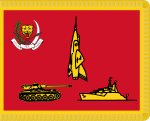 | 1971–1997 | Presidential standard of Zaire | |
 | 1936–1960 | Standard of the governor-general of the Belgian Congo | Flag of the Belgian Congo superimposed on the top left of the flag of Belgium |
| Flag | Date | Use | Description |
|---|---|---|---|
 | 1960–1967 | Flag of Léopoldville | |
 | 1967–2011 | Flag of Kinshasa | |
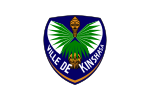 | 2011–present | Flag of Kinshasa |
| Flag | Date | Party | Description |
|---|---|---|---|
 | 2009–Present | Future of Congo | |
| Flag | Date | Use | Description |
|---|---|---|---|
 | 2006–present | Flag of National Congress for the Defence of the People | The design of this flag resembles the flag of Zaire. |
 | 1996–present | Flag of Allied Democratic Forces | |
 | 2014–present | Flag of Nduma Defense of Congo-Renovated | |
 | 2000–present | Flag of Democratic Forces for the Liberation of Rwanda | |
 | 2010s–present | Separatist flag of Kivu | |
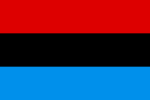 | 1987–present | Flag of the Lord's Resistance Army |
| Flag | Date | Use | Description |
|---|---|---|---|
 | ?–present | Flag of Batwa (originally it was only represented by Batwa in Rwanda) | |
 | ?–present | Flag of the Bakongo in DMK |
| Flag | Date | Associated state | Design | Notes |
|---|---|---|---|---|
 | 1876–1879 | International African Association | Blue background emblazoned with a central yellow five-pointed star | The blue background symbolises the Congo River and the yellow star (which is still used) symbolises both unity, [1] and a bright future. [2] It was the only flag used during the entire period of colonial Belgian administration. |
| 1879–1885 | International Association of the Congo | |||
| 1885–1908 | Congo Free State | |||
| 1908–1960 | Belgian Congo | |||
 | 1960–1963 | First Congolese Republic | An additional six yellow five-pointed stars are added to the hoist | The added stars represent the six state provinces existing at the time of independence from Belgium. [2] |
 | 1963–1964 | A yellow five-pointed star sitting alongside a red and gold bend sinister on a blue background | The red bend represents the blood of martyrs, and the gold frame represents the riches of the land. [1] | |
| 1964–1966 | Democratic Republic of the Congo | |||
 | 1966–1971 | The red and gold bend sinister was changed to a reduced bend sinister | ||
 | 1971–1997 | Republic of Zaire | Light green emblazoned with a yellow circle containing an arm holding a red torch | Filled with Pan-African colours, the flag has a central emblem which is that of the Popular Movement. The torch symbolises the spirit of revolution and the lives of dead revolutionaries. [3] |
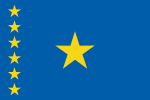 | 1997–2003 | Democratic Republic of the Congo | ||
 | 2003–2006 |
| Flag | Date | Use | Description |
|---|---|---|---|
 | 1895–1908 | Flag of the Batetela Rebels | |
 | 1960–1962 | Flag of the South Kasai | |
 | 1960–1963 | Flag of the State of Katanga | |
 | 1971–1997 | Flag of the Armed Forces of Zaire | Similar to the Presidential Standard of Zaire |
| Flag | Date | Use | Description |
|---|---|---|---|
 | May 1960 | Anti-Lumumbist proposal for the flag of Congo-Léopoldville |

The economy of the Democratic Republic of the Congo has declined drastically around the 1980s, despite being home to vast potential in natural resources and mineral wealth; their gross domestic product is $69.474 billion as of 2023. During the last five reported years the exports of Democratic Republic of the Congo have changed by $15.2B from $13.3B in 2017 to $28.5B in 2022.

The Democratic Republic of the Congo, also known as Congo-Kinshasa, Congo DR, DR Congo, DRC, or simply either Congo or the Congo, is a country in Central Africa. By land area, the DRC is the second-largest country in Africa and the 11th-largest in the world. With a population of around 105 million, the Democratic Republic of the Congo is the most populous Francophone country in the world, and the fourth-largest in Africa. The national capital and largest city is Kinshasa, which is also the economic center. The country is bordered by the Republic of the Congo, Central African Republic, South Sudan, Uganda, Rwanda, Burundi, Tanzania, Zambia, Angola, the Cabinda exclave of Angola, and the South Atlantic Ocean.

Pan-African colours is a term that may refer to two different sets of colours:

The national flag of Azerbaijan, often referred to in Azerbaijani as üçrəngli bayraq, is a horizontal tricolour that features three equally sized bars of bright blue, red, and green; a white crescent; and a centred eight-pointed star. The flag has become the predominant and most recognizable symbol of Azerbaijan. The bright blue represents Azerbaijan's Turkic identity, the red represents progress, and the green represents Islam, which is Azerbaijan's majority religion.

The national flag of the Democratic Republic of the Congo is a sky blue flag, adorned with a yellow star in the upper left canton and cut diagonally by a red stripe with a yellow fimbriation. It was adopted on 18 February 2006. A new constitution, ratified in December 2005 and which came into effect in February 2006, promoted a return to a flag similar to that flown between 1963 and 1971, with a change from a royal blue to sky blue background. Blue represents peace. Red stands for "the blood of the country's martyrs", yellow the country's wealth; and the star symbol the future for the country. It is one of the few national flags incorporating a diagonal line, with other examples including Tanzania, Namibia, Trinidad and Tobago, and Brunei.

The national flag of the Republic of the Congo consists of a yellow diagonal band divided diagonally from the lower hoist-side corner, with a green upper triangle and red lower triangle. Adopted in 1959 to replace the French Tricolour, it was the flag of the Republic of the Congo until 1970, when the People's Republic of the Congo was established. The new regime changed the flag to a red field with the coat of arms of the People's Republic in the canton. This version was utilized until the regime collapsed in 1991. The new government promptly restored the original pre-1970 flag.

The Luvua River is a river in the Katanga Province of the Democratic Republic of the Congo (DRC). It flows from the northern end of Lake Mweru on the Zambia-Congo border in a northwesterly direction for 350 kilometres (220 mi) to its confluence with the Lualaba River opposite the town of Ankoro. The Lualaba becomes the Congo River below the Boyoma Falls.
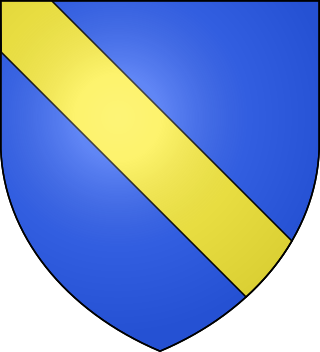
In heraldry, a bend is a band or strap running from the upper dexter corner of the shield to the lower sinister. Authorities differ as to how much of the field it should cover, ranging from one-fifth up to one-third.
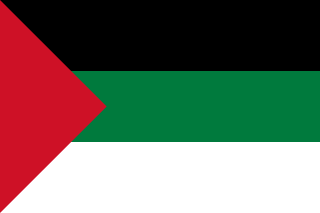
The pan-Arab colors are black, white, green and red. Individually, each of the four pan-Arab colors were intended to represent a certain aspect of the Arab people and their history.

The Lukuga River is a tributary of the Lualaba River in the Democratic Republic of the Congo (DRC) that drains Lake Tanganyika. It is unusual in that its flow varies not just seasonally but also due to longer term climate fluctuations.

BMS World Mission, officially Baptist Missionary Society, is a Christian missionary society founded by Baptists from England in 1792. The headquarters is in Didcot, England.

These are the various flags of Africa.

The Operational Service Medal for the Democratic Republic of the Congo is a British armed forces campaign medal, awarded mostly to military personnel who served between 14 June and 10 September 2003 on Operation Coral.

The flag of Macedonia represents a Vergina Sun with 16 rays in the centre of a blue field. This flag, as well as the Vergina Sun, is commonly used as an unofficial symbol of the Greek region of Macedonia and its subdivisions. It is also used by organisations of the Greek Macedonian diaspora, such as the Pan-Macedonian Association chapters of the United States and Australia, as well as numerous commercial enterprises and private citizens.

The Betsy Ross flag is a reconstructed early design for the flag of the United States, which is conformant to the Flag Act of 1777 and has red stripes outermost and stars arranged in a circle. These details elaborate on the 1777 act, passed early in the American Revolutionary War, which specified 13 alternating red and white horizontal stripes and 13 white stars in a blue canton. Its name stems from the story, once widely believed, that shortly after the 1777 act, upholsterer and flag maker Betsy Ross produced a flag of this design.
An ethnic flag is a flag that symbolizes a certain ethnic group. Ethnic flags are often introduced to the ethnic community through the respective cultural or political ethnic movements. They are popular among diasporas, ethnic minorities, and some ethnic majorities, especially in multiethnic countries.

The Republic of the Congo, also known as Congo-Brazzaville, West Congo, Congo Republic, ROC, or simply either Congo or the Congo, is a country located on the western coast of Central Africa to the west of the Congo River. It is bordered to the west by Gabon, to the northwest by Cameroon, to the northeast by the Central African Republic, to the southeast by the Democratic Republic of the Congo, to the south by the Angolan exclave of Cabinda, and to the southwest by the Atlantic Ocean.

United Nations Security Council resolution 1493, adopted unanimously on 28 July 2003, after recalling all resolutions on the situation in the Democratic Republic of the Congo, the council extended the mandate of the United Nations Mission in the Democratic Republic of Congo (MONUC) until 30 July 2004 and raised its troop level from 8,700 to 10,800.